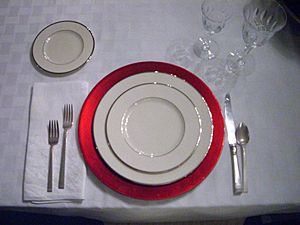Charger (table setting) facts for kids
Charger plates are large plates used for special meals like big dinners, parties, or weddings. They have been used since the 1800s. These plates are mostly for decoration and are not usually used to serve food directly. People often call them underplates or service plates.
Contents
What are Charger Plates?
Charger plates are usually bigger than regular dinner plates. Since food is not served on them, they can be made from many different materials. You might find them made of china, metal, wood, glass, plastic, or even pearl. They can also have fancy decorations.
The word "charger" comes from a Middle English word, "chargeour," which meant a large platter or a shallow dish for liquids.
How are Charger Plates Used?
The way charger plates are used can be a bit different depending on the event.
- Some professional catering companies remove the charger plate as soon as guests sit down.
- Other times, if the charger plate matches the dinner plates, it stays on the table during the meal. It acts as a base for other bowls and plates, like soup bowls or salad plates.
- Charger plates are always removed before dessert is served. You will never see a charger plate when dessert comes out!
Charger Plates Around the World
In Europe, especially with a serving style called service à la russe, charger plates are known as service plates. They stay on the table for the first few courses. For example, a soup bowl might sit on top of the service plate. After the soup, both the soup bowl and the service plate are taken away. A warm, empty plate is then put in their place. This way, there is always a plate in front of each guest until just before dessert.
See also
 In Spanish: Bajoplato para niños
In Spanish: Bajoplato para niños


